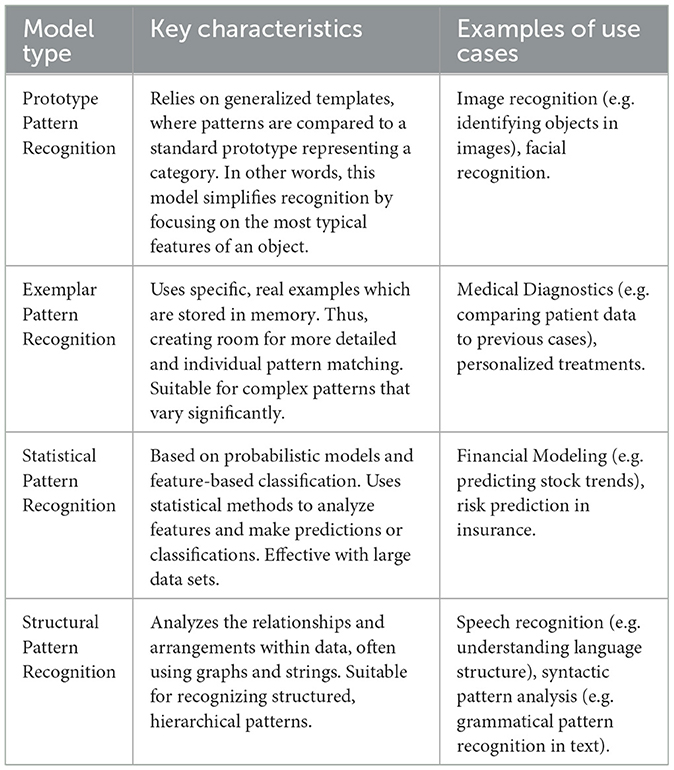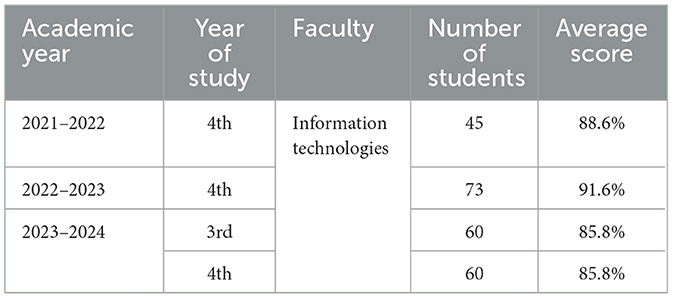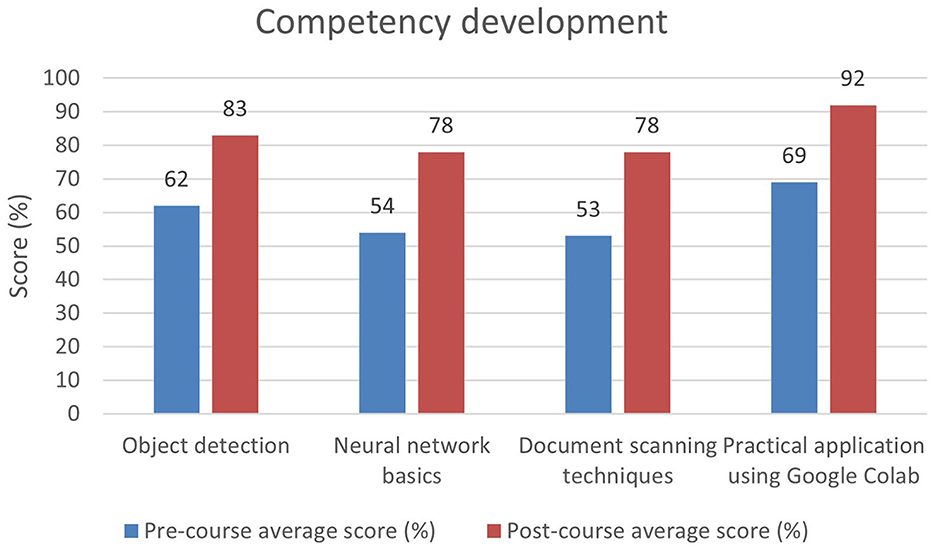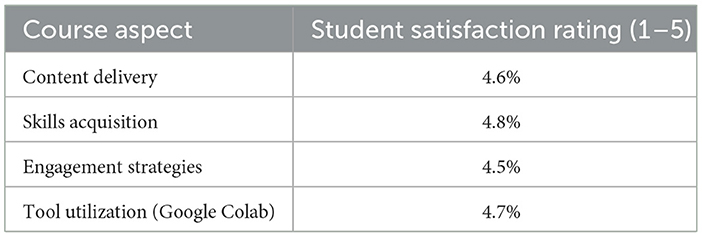- 1Applied Mathematics and Informatics Department, Buketov Karaganda State University, Karaganda, Kazakhstan
- 2Department of Psychology, Semey State University, Semey, Kazakhstan
- 3Faculty of Innovative Technologies, Buketov Karaganda State University, Karaganda, Kazakhstan
- 4Department of Transport and Logistics, Buketov Karaganda State University, Karaganda, Kazakhstan
- 5Pavlodar Pedagogical University, Pavlodar, Kazakhstan
Pattern recognition is a cornerstone of Artificial Intelligence (AI), shaping critical applications such as image analysis, speech processing, and automated decision-making. This study examines the impact of university curricula on developing AI competencies through dedicated pattern recognition training. A mixed-methods approach was employed to assess student comprehension, curriculum effectiveness, and challenges in mastering advanced concepts. The analysis reveals that structured coursework significantly enhances practical AI skills; therefore, recommendations include integrating more hands-on experiences and continuously updating course content. Such refinements promise to better prepare students for real-world challenges and industry demands. In conclusion, evolving instructional practices are essential for robust AI expertise.
1 Introduction
Artificial Intelligence (AI) has transformed various industries by automating human tasks. Consequently, pattern recognition, a key AI component, allows machines to analyze data and make predictions (Slimi and Carballido, 2023). In AI education, understanding pattern recognition is crucial for students aiming to build intelligent systems. Hence, universities increasingly integrate digital tools into their curricula, enhancing learning experiences. Research in Kazakhstan highlights the benefits of such integration, demonstrating improved student performance when technology-driven teaching is employed (Tokzhigitova et al., 2023). For instance, Karatayeva et al. (2024) demonstrated that incorporating digital tools and interactive simulations into renewable energy education significantly improved student outcomes. Students who engaged with technology-enhanced curricula outperformed their peers in traditional settings, underscoring the effectiveness of digital learning environments. Similarly, Kuanbayeva et al. (2024) explored augmented reality (AR) in science education, finding that AR not only enhanced learning outcomes but also improved engagement, communication, and collaboration skills. Moreover, Serik et al. (2024) examined big data education in Kazakhstani universities, emphasizing the importance of practical training in data processing and analysis using algorithms like k-means clustering. Collectively, these studies reflect a growing commitment to digital education, aligning with the need for pattern recognition training in AI curricula to equip students with essential skills for handling large datasets and building intelligent systems.
The aim of this study is to evaluate the effectiveness of the pattern recognition syllabus in enhancing student's understanding and skills which are related to AI, neutral networks and image recognition technologies. Similarly, the objectives supporting this aim include:
• To examine how pattern recognition is interlinked with the advancement of Artificial Intelligence in the 21st century.
• To assess the depth of knowledge that students gain in pattern recognition concepts and AI technologies.
• To evaluate the impact of course content on student's ability to independently develop pattern recognition systems for AI.
This study begins by examining foundational literature on pattern recognition and AI, covering its origins and how modern universities integrate essential skills and digital tools into their curricula. The review also highlights gaps within existing findings. The methodology section employs a qualitative approach, using coursework analysis, pre- and post-assessments, and content analysis to ensure the study's aims and objectives are fully addressed. In this context, Karaganda University's pattern recognition curriculum, course code 6B06103, will be evaluated to identify areas that either support or limit student learning. This will be followed by a results section that examines the curriculum's strengths and weaknesses, particularly its impact on developing AI skills in students, both in understanding AI and in applying these skills to real-world scenarios. Finally, the conclusion will summarize the study's findings.
2 Comprehensive theoretical basis
2.1 Pattern recognition and AI education
Pattern recognition enables machines to process and classify information in ways that mimic human cognition (Basu et al., 2010). Batchelor (2012) illustrates this by comparing machine learning to how children recognize objects—through repeated exposure and pattern association. AI, first coined by McCarthy in 1955 (Guan et al., 2020), has evolved into a field where technologies such as machine learning and neural networks allow for decision-making based on vast datasets. However, these systems require skilled professionals to design and optimize them for various applications, from medical diagnostics to automated decision-making. The rapid growth of AI has led universities to prioritize AI education, incorporating courses in machine learning, robotics, and natural language processing (Chen et al., 2022). Shiohira (2021) highlights that AI-driven automation could significantly impact the workforce, making AI literacy essential for future professionals. Many universities now integrate AI-powered platforms such as Altitude Learning and Gradescope, which adapt to students' learning paces and reinforce personalized education (Issayeva, 2024). Pattern recognition is central to AI curricula, with key models such as prototype and exemplar recognition forming the basis of AI applications (Fontanella et al., 2020). A summary of the main pattern recognition models, their core features, and application domains is presented in Table 1 to support understanding of how these approaches contribute to different areas of AI practice. Prototype recognition relies on generalized templates for classification, making it useful for image and speech recognition, while exemplar recognition stores specific examples for comparison, which is critical in medical diagnostics (Bonnet, 2000). Additionally, statistical and structural recognition models contribute to AI applications in finance, security, and language processing (Baron, 2006).
To demonstrate how pattern recognition can be effectively taught as a dedicated subject, Table 2 presents an overview of the weekly structure of the “Pattern Recognition” course implemented at Karaganda University. The course design reflects the principles of experiential learning and digital pedagogy, combining theoretical instruction with tool-based implementation. It gradually progresses from foundational AI tasks to advanced neural network applications, using platforms such as Python, OpenCV, Google Colab, and TensorFlow. This structure offers a practical and scalable model for other institutions aiming to enhance AI curricula.
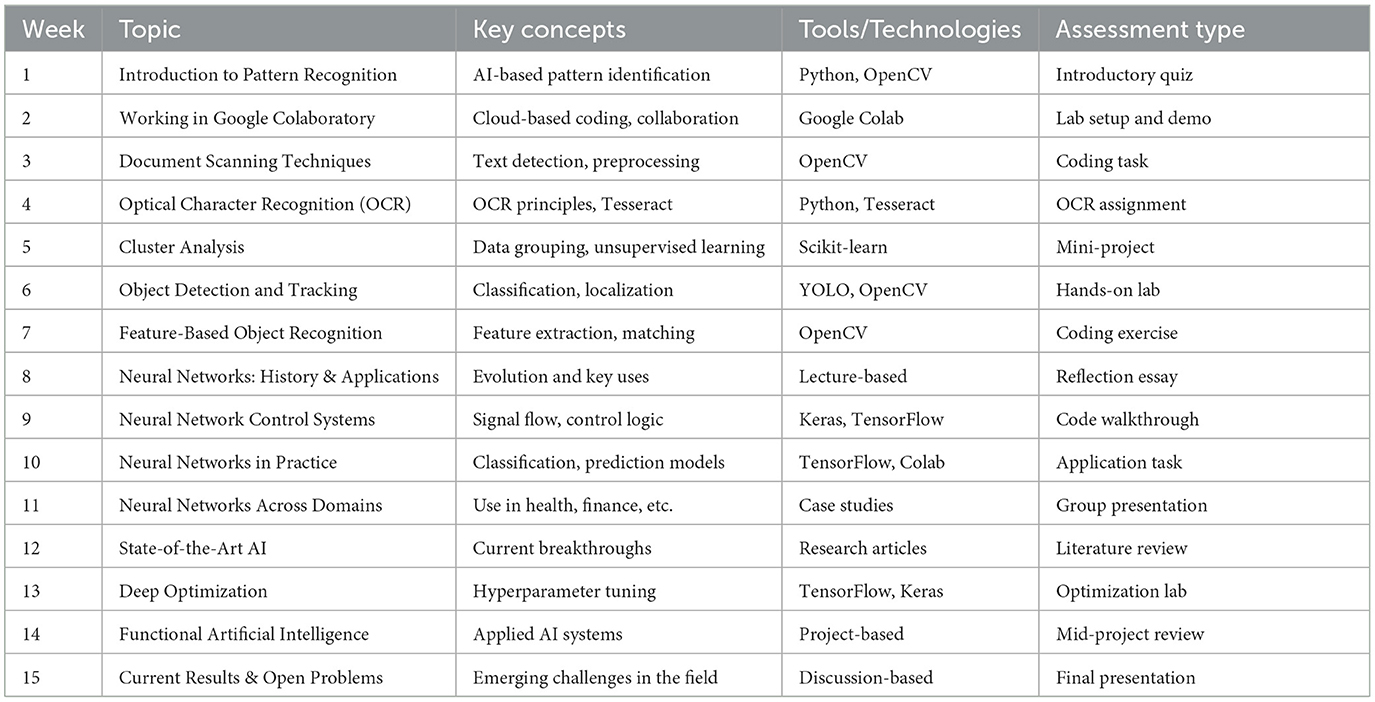
Table 2. Weekly syllabus outline for the “pattern recognition” course: topics, concepts, tools, and assessments.
2.2 Gaps in existing literature
Despite the significant attention given to pattern recognition in AI education, there are crucial areas within the exploration of this framework that remain underdeveloped. The first notable gap is that pattern recognition is rarely treated as a standalone course in university curricula. Instead, it is frequently bundled into broader courses such as machine learning or data science (Paolanti and Frontoni, 2020). While these subjects are closely related, the depth and centrality of pattern recognition within AI systems justify its inclusion as a distinct course (Zhang et al., 2021; Chen et al., 2022). By addressing it as a subset within other courses, universities risk undermining its importance, thus leaving students with a fragmented understanding of pattern recognition as a foundational skill in AI education.
Another gap lies in how pattern recognition models are presented in educational materials. Often, they are either too simplistic or overly complex, making it difficult for students to grasp key concepts effectively. For instance, some models described in research by Batchelor (2012); Data (2024) are highly detailed but may overwhelm students who are new to the subject. This creates a need for more balanced teaching materials that bridge theoretical knowledge with practical applications, making pattern recognition more accessible to students at varying levels of AI expertise.
Furthermore, research on the role of pattern recognition education in student success and career readiness remains limited. While the technical efficiency of AI systems utilizing pattern recognition has been well documented (Paolanti and Frontoni, 2020), studies focusing on its direct impact on students' problem-solving and adaptability skills are scarce. This study is grounded in the theoretical framework of experiential learning, which emphasizes learning through doing—particularly through hands-on projects, real-world problem-solving, and iterative application of knowledge. By embedding experiential strategies within pattern recognition instruction, we align AI education with pedagogical models that support deep, transferable learning.
Additionally, the findings extend conversations in digital pedagogy by showing how structured, tool-based instruction (e.g., using Python, OpenCV, and Google Colab) helps students bridge conceptual understanding and applied skill development. This approach supports the design of more effective AI curricula that not only deliver content but also cultivate problem-solving skills in authentic learning contexts.
Hence, further research should assess how mastering pattern recognition influences students' ability to innovate and apply AI solutions in real-world scenarios. Deducing from these studies, it can be stated that integrating pattern recognition into AI education is crucial for equipping students with the skills needed to build adaptive AI systems. Universities should emphasize structured pattern recognition courses, ensuring students can apply these concepts in real-world AI applications. Future research should explore the long-term benefits of pattern recognition training in professional AI careers.
3 Methodology
This study adopted a mixed-methods approach, integrating qualitative and quantitative research to analyze students' experiences and learning outcomes. A structured research design facilitated a systematic investigation, aligning with claims in previous work, that research should transition logically from problem formulation to conclusion (Maxwell, 2013). Qualitative research, rooted in constructionism and phenomenology, provided insights into students' perspectives on curriculum relevance and teaching methodologies (Onwuegbuzie and Leech, 2007). A student-centered sampling strategy was used to include participants from diverse academic backgrounds, ensuring a nuanced understanding of how the curriculum influenced learning experiences. The sampling followed a purposive strategy, targeting third- and fourth-year undergraduate students enrolled in Information Technology and Computer Science programs who had completed the Pattern Recognition course. A total of 60 students participated, selected for their direct exposure to the course content and ability to reflect on learning outcomes. Data was collected through interviews, surveys, coursework reviews, and observations. Pre- and post-test assessments measured knowledge acquisition, while surveys and semi-structured interviews explored students' satisfaction and self-reported progress. Coursework analysis further assessed students' ability to apply pattern recognition skills in AI development. Content analysis, following Stemler's approach identified patterns in curriculum effectiveness and student feedback (Stemler, 2015). Thematic analysis highlighted recurring themes, pinpointing strengths and areas for curriculum improvement. Findings indicated that hands-on projects and real-world applications enhanced student engagement and comprehension (Chen et al., 2022). However, students noted challenges in mastering complex pattern recognition concepts, emphasizing the need for additional support. Instructors also reported that embedding pattern recognition within broader AI courses sometimes limited in-depth understanding. Therefore, while the curriculum proved effective, integrating more real-world applications and refining content delivery could further enhance learning outcomes. Future improvements should focus on bridging theoretical and practical components to ensure students develop the necessary AI expertise for industry applications.
4 Results and discussion
This section evaluates the effectiveness of the “Pattern Recognition” course (6B06103—Information Systems) at Karaganda University, focusing on content delivery, student engagement, satisfaction, and performance trends. The findings highlight the course's impact on student learning outcomes and preparedness for AI-focused careers.
Student Enrollment and Performance Trends: Student enrollment has steadily increased in the Information Technologies faculty, especially for the “Pattern Recognition” course. The data from the past three academic years show rising enrollment and high academic achievement, as illustrated in Table 3. The increase in scores, particularly in 2022–2023 when AI topics were added, suggests that curriculum updates contribute to improved student performance.
Skills Acquisition and Practical Application: Student assessments before and after the course show significant improvement in skills such as object detection and neural network understanding, especially with tools like Google Colab, Python, and OpenCV. This is reflected in the data presented in Figure 1. These practical tools have elevated both theoretical knowledge and real-world application of AI concepts.
Student Engagement and Satisfaction: Survey results demonstrate strong engagement during practical sessions, with high satisfaction ratings, particularly for skills acquisition and tool utilization (Table 4). However, students suggested more structured guidance for advanced topics like neural networks.
Equipping AI Students for Real-World Development: The course prepares students with both theoretical and practical knowledge, essential for developing AI systems. As the findings indicate, incorporating AI tools like Google Colab and OpenCV significantly boosts students' practical skills, which are vital for AI careers. The practical sessions reinforce learning, making students more confident in their abilities.
5 Recommendations for course improvement
While the course is comprehensive, areas for improvement include:
• Enhanced Guidance for Advanced Topics: Some students found topics like neural networks challenging. Providing additional resources and structured tutorials could improve understanding. Educators could implement scaffolded assignments that gradually introduce neural network architectures, supported by step-by-step video walkthroughs and visual simulations to demystify abstract concepts.
• Accessible Teaching Materials: Simplifying complex materials could balance theory and practical application, making pattern recognition more accessible to all skill levels. Using interactive visualizations and annotated code notebooks in platforms like Google Colab may help students better connect theory to implementation.
• Research on Educational Impact: More research is needed to evaluate the specific benefits of teaching pattern recognition in terms of real-world problem-solving and adaptability. Future iterations of the course could also include structured lab modules using tools like OpenCV and TensorFlow, accompanied by dedicated tutorial sessions that support students with varying programming backgrounds.
6 Conclusion
This study emphasizes the role of pattern recognition in developing AI competencies. Results show significant improvement in students' skills in machine learning and data analysis, increasing their readiness for AI careers. However, integrating pattern recognition into broader courses dilutes its importance. Future courses should focus on pattern recognition as a standalone subject to enhance student understanding and career readiness. Future research should continue exploring the impact of targeted pattern recognition education on AI career preparation.
While this research provides valuable insights, it is based on a single institutional context within Kazakhstan. Institutional, cultural, and curricular differences in other countries may affect how pattern recognition is taught and perceived. Therefore, caution should be taken when generalizing these findings across global educational settings. Future studies should consider comparative analyses across multiple universities and regions to explore how localized factors influence learning outcomes in AI-related subjects.
Data availability statement
The raw data supporting the conclusions of this article will be made available by the authors, without undue reservation.
Ethics statement
The studies involving humans were approved by Ethics Committee of Buketov Karaganda State University. The studies were conducted in accordance with the local legislation and institutional requirements. The participants provided their written informed consent to participate in this study.
Author contributions
DK: Conceptualization, Methodology, Supervision, Writing – review & editing. NS: Conceptualization, Investigation, Visualization, Writing – original draft. GS: Data curation, Formal analysis, Funding acquisition, Project administration, Writing – review & editing. AZ: Formal analysis, Resources, Validation, Writing – review & editing. BS: Formal analysis, Investigation, Writing – original draft.
Funding
The author(s) declare that no financial support was received for the research and/or publication of this article.
Conflict of interest
The authors declare that the research was conducted in the absence of any commercial or financial relationships that could be construed as a potential conflict of interest.
Generative AI statement
The author(s) declare that no Gen AI was used in the creation of this manuscript.
Publisher's note
All claims expressed in this article are solely those of the authors and do not necessarily represent those of their affiliated organizations, or those of the publisher, the editors and the reviewers. Any product that may be evaluated in this article, or claim that may be made by its manufacturer, is not guaranteed or endorsed by the publisher.
References
Baron, R. A. (2006). Opportunity recognition as pattern recognition: how entrepreneurs “connect the dots” to identify new business opportunities. Acad. Manag. Perspect. 20, 104–119. doi: 10.5465/amp.2006.19873412
Basu, J. K., Bhattacharyya, D., and Kim, T. H. (2010). Use of artificial neural network in pattern recognition. IJSEA. 4, 23–34.
Bonnet, N. (2000). “Artificial intelligence and pattern recognition techniques in microscope image processing and analysis,” in Advances in Imaging and Electron Physics (Amsterdam: Elsevier), 1–77.
Chen, X., Zou, D., Xie, H., Cheng, G., and Liu, C. (2022). Two decades of artificial intelligence in education. Educ. Technol. Soc. 25, 28–47. doi: 10.1007/s10639-022-11399-5
Data, L. Y. (2024). Pattern Recognition in Machine Learning. Available online at: https://labelyourdata.com/articles/pattern-recognition-in-machine-learning (accessed January 25, 2025).
Fontanella, F., Colace, F., Molinara, M., Freca, A. S., and Stanco, F. (2020). Pattern recognition and artificial intelligence techniques for cultural heritage. Pattern Recognit. Lett. 138, 23–29. doi: 10.1016/j.patrec.2020.06.018
Guan, C., Mou, J., and Jiang, Z. (2020). Artificial intelligence innovation in education: a twenty-year data-driven historical analysis. Int. J. Innov. Stud. 4, 134–147. doi: 10.1016/j.ijis.2020.09.001
Issayeva, Z. K. (2024). Language teaching and technology: integration of artificial intelligence tools and digital platforms for educational purposes. Lang. Teach. Technol. Integr. Artif. Intell. Tools Digit. Platf. Educ. Purp. Linguist. Philos. Investig. Philolinginvestigationscom 23, 1315–1319.
Karatayeva, Z., Abildinova, G., Karaca, C., and Mukhtarkyzy, K. (2024). Integrated application of digital technologies in interconnected energy sources in renewable energy education. World Trans. Eng. Technol. Educ. 22, 196–204.
Kuanbayeva, B., Shazhdekeyeva, N., Zhusupkaliyeva, G., Mukhtarkyzy, K., and Abildinova, G. (2024). Investigating the role of augmented reality in supporting collaborative learning in science education: a case study. Int. J. Eng. Pedagogy 14, 149–161. doi: 10.3991/ijep.v14i1.42391
Maxwell, J. A. (2013). Qualitative Research Design: An Interactive Approach: An Interactive Approach.
Onwuegbuzie, A. J., and Leech, N. L. (2007). Sampling designs in qualitative research: making the sampling process more public. Qual. Rep. 12, 238–254. doi: 10.46743/2160-3715/2007.1636
Paolanti, M., and Frontoni, E. (2020). Multidisciplinary pattern recognition applications: a review. Comput. Sci. Rev. 37:100276. doi: 10.1016/j.cosrev.2020.100276
Serik, M., Nurbekova, G., Mukhambetova, M., and Zulpykhar, Z. (2024). The educational content and methods for big data courses including big data cluster analysis. World Trans. Eng. Technol. Educ. 22, 203–207.
Shiohira, K. (2021). Understanding the impact of artificial intelligence on skills development. UNESCO-UNEVOC Int. Cent. Tech. Vocat. Educ. Train.
Slimi, Z., and Carballido, B. V. (2023). Navigating the ethical challenges of artificial intelligence in higher education: an analysis of seven global AI ethics policies. Navig. Ethical Chall. Artif. Intell. High. Educ. Anal. Seven Glob. AI Ethics Policies Temjournalcom 12. doi: 10.18421/TEM122-02
Stemler, S. E. (2015). “Content analysis. Emerging trends in the social and behavioral sciences: an interdisciplinary, searchable, and linkable resource,” in Emerging Trends in the Social and Behavioral Sciences (researchgate.net), eds. R. A. Scott and S. M. Kosslyn (Hoboken, NJ: Wiley), 1–14.
Tokzhigitova, A., Yermaganbetova, M., and Tokzhigitova, N. (2023). Determining the activity of students through the elements of gamification. IJEP. 13, 65–78. doi: 10.3991/ijep.v13i7.41885
Keywords: pattern recognition, artificial intelligence education, AI skills development, machine learning, neural networks
Citation: Kazimova D, Serikbayeva N, Samashova G, Zatyneyko A and Sarsenbayeva B (2025) Evaluating the impact of pattern recognition on AI skills development in universities. Front. Educ. 10:1592209. doi: 10.3389/feduc.2025.1592209
Received: 19 March 2025; Accepted: 07 April 2025;
Published: 07 May 2025.
Edited by:
Davide Girardelli, University of Gothenburg, SwedenReviewed by:
Taejong Kim, National Institute of Meteorological Sciences, Republic of KoreaAinur Tokzhigitova, S. Toraighyrov Pavlodar State University, Kazakhstan
Copyright © 2025 Kazimova, Serikbayeva, Samashova, Zatyneyko and Sarsenbayeva. This is an open-access article distributed under the terms of the Creative Commons Attribution License (CC BY). The use, distribution or reproduction in other forums is permitted, provided the original author(s) and the copyright owner(s) are credited and that the original publication in this journal is cited, in accordance with accepted academic practice. No use, distribution or reproduction is permitted which does not comply with these terms.
*Correspondence: Nurgul Serikbayeva, bi5zZXJpa2JhZXZhQHNlbWd1Lmt6
 Dinara Kazimova1
Dinara Kazimova1 Nurgul Serikbayeva
Nurgul Serikbayeva